MSI GE40 Review: a Slim Gaming Notebook
by Jarred Walton on July 16, 2013 3:00 AM ESTMSI GE40 Gaming Performance
Our notebook gaming suite is now set for 2013, and I'm toying with the addition of Company of Heroes 2 as a second RTS/strategy data point. We’re still collecting performance results for CoH2, however, so for now I’ll refer you to Mobile Bench for those numbers. Let's just say that the game can bring even powerful notebooks to their knees.
We’ve also got the GTX 680M courtesy of the Alienware M17x R4 in the gaming charts, along with the other notebooks from the previous page. Here are the charts, and please take the time to read the commentary before trying to draw too many conclusions as there’s more going on than may at first be apparent. We’ll start with the Value charts, where the CPU becomes even more of a factor, and then move on to the Mainstream charts.
Notebook “Value” Gaming Performance
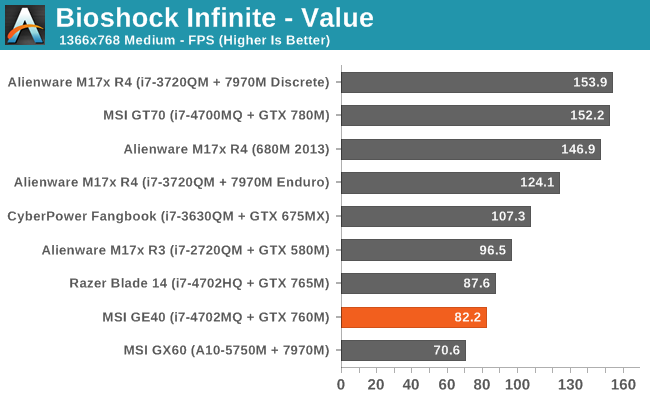
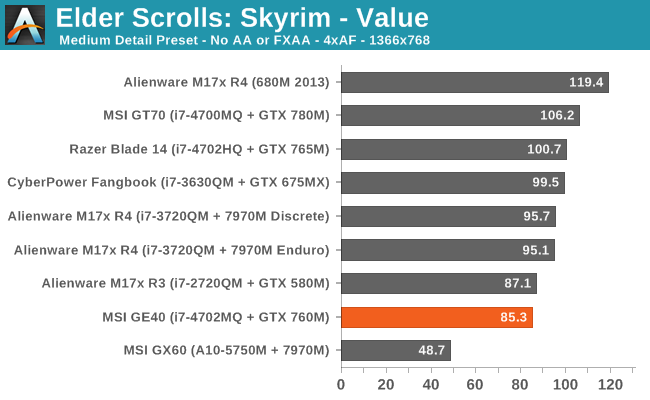
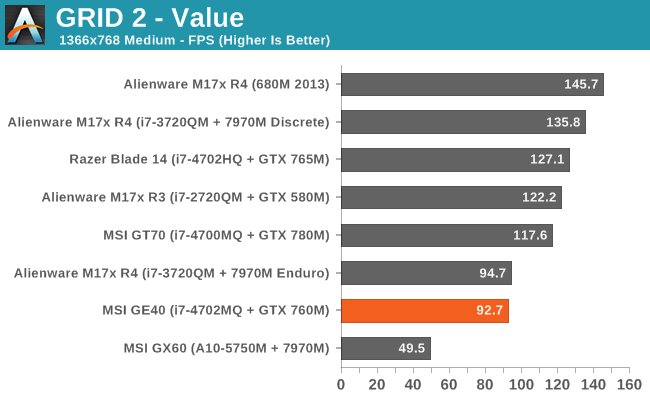
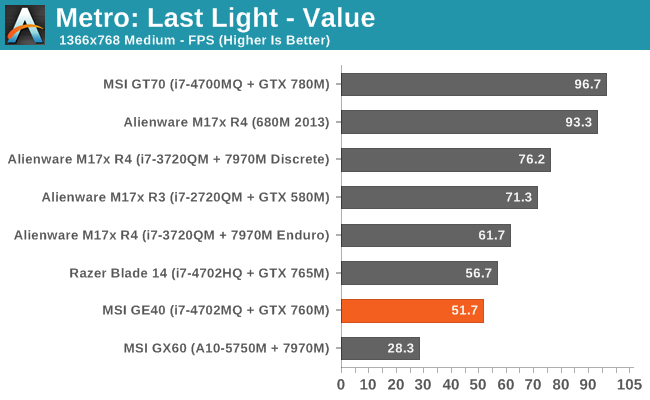
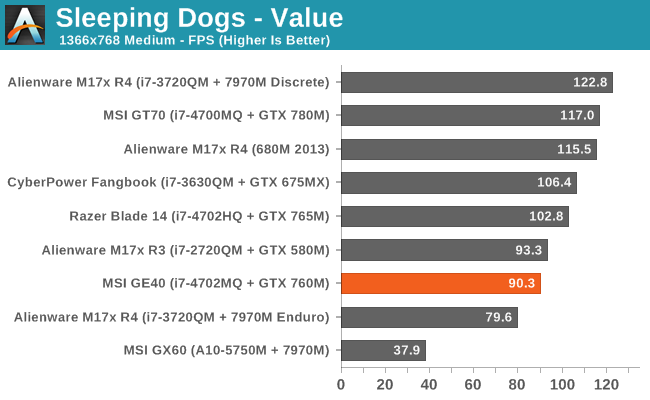
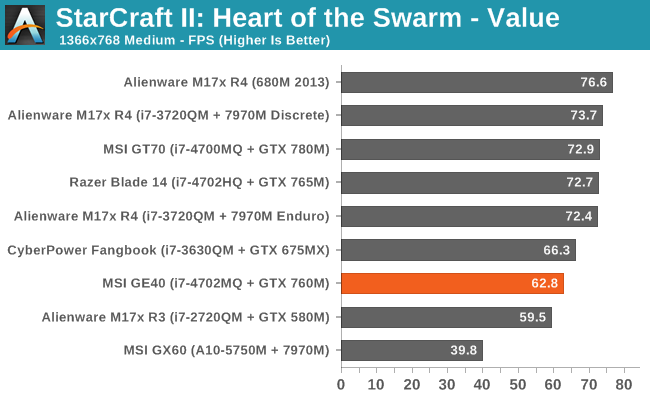
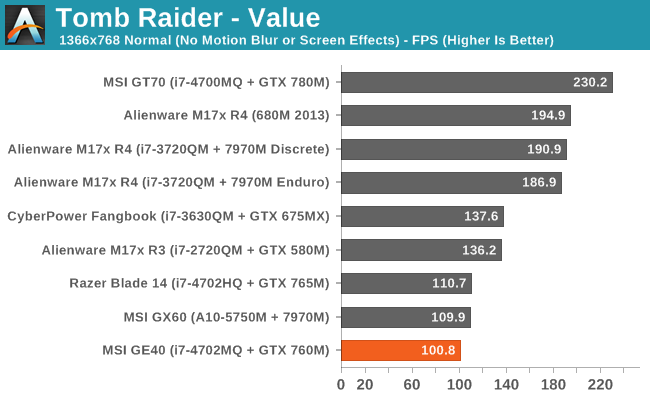
Notebook “Mainstream” Gaming Performance
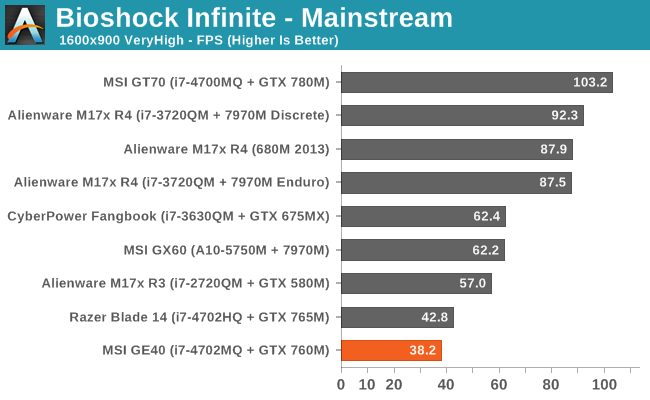

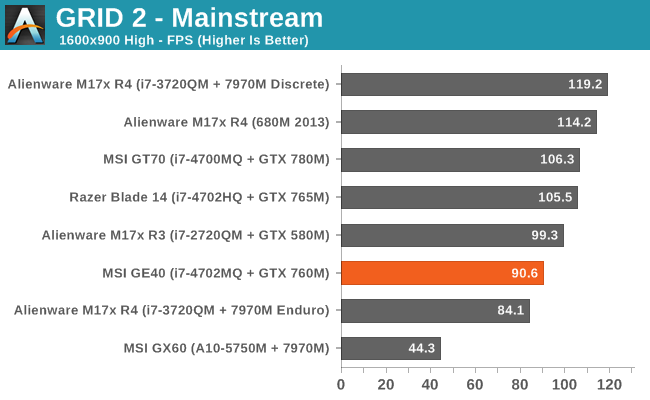
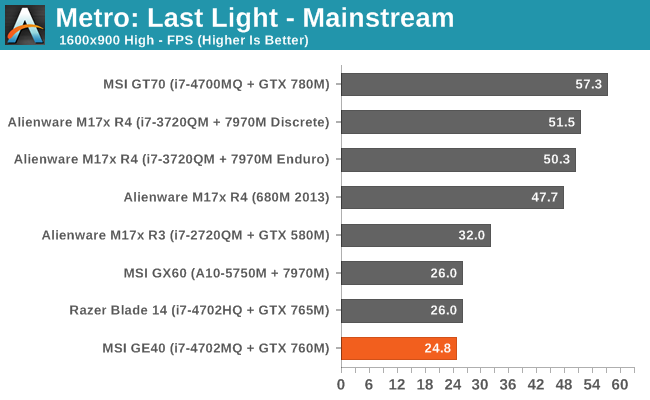
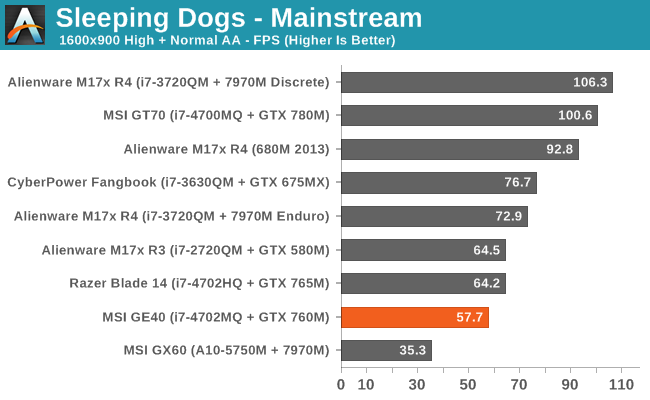
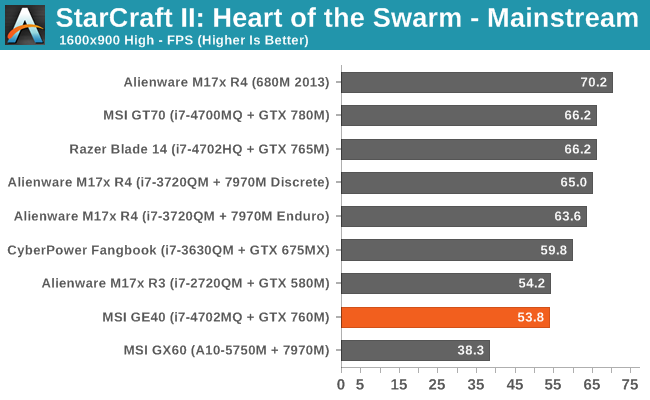
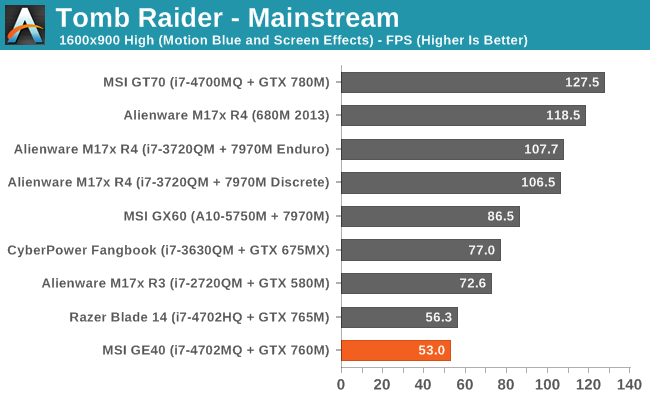
First, let me get this out of the way: the GTX 780M performance looks rather poor in many of these gaming benchmarks. The reason isn’t that our benchmarks are inherently flawed or even that the MSI GT70 is a “lemon”; rather, we’re looking at lower quality settings where the CPU plays a much greater role. We have another laptop (Clevo P157SM) with i7-4700MQ and GTX 780M, and while it’s sometimes up to 7% faster than the GT70, there are also instances where the GT70 wins by 5%; on average, our P157SM numbers average out to 0.01% faster at our Value settings and 1.3% faster at our Mainstream and Enthusiast settings.
The long and short of it is that the GTX 780M needs more CPU to really stretch its legs in some games; we’ll have a full review and investigation of CPU scaling with the GTX 780M in the future, but no matter how crazy it might seem, the results from our GT70 review aren’t far off of what you can expect in the games we’ve benchmarked at the settings we’ve used. Certain titles in particular are very CPU limited (Skyrim and StarCraft II), even at higher quality settings, and the i7-3820QM ends up being faster than the i7-4700MQ by a decent margin. (Note that the i7-4700MQ is really the replacement for the i7-3610QM, so the 3820QM is two steps above the 4700MQ.)
We can get a better idea of where the CPU matters most and where it matters least by looking at the performance of the MSI GX60. The HD 7970M is definitely faster than the GTX 760M and GTX 765M in most disciplines (e.g. look at the M17x 7970M discrete results; on average it’s 29%/41% faster than the 765M at Value/Mainstream and 50%/61% faster than the 760M), so when it loses—especially by a large margin—to the GE40, we’re looking at CPU bottlenecks. The only Value benchmark where the GX60 beats the GE40 is Tomb Raider; elsewhere it’s anywhere from 14% (Bioshock) to 58% (Sleeping Dogs) slower, and on average the GE40 runs through our Value suite 47% faster than the GX60! At the more demanding Mainstream settings, the gap narrows and the GX60 now claims wins in Bioshock, Metro: Last Light, and Tomb Raider; the GE40 is still 15% faster on average, with large wins in Skyrim, GRID 2, and Tomb Raider. It’s only at our Enthusiast settings that the GX60 starts to win in a majority of the games we’re testing. (Those scores aren’t shown here but they’re available in Bench—we figure with a 1600x900 panel and moderate GPU we didn’t need to show maxed out 1080p performance, but it’s still interesting to see how the GTX 760M handles those settings.)
Other than the GTX 780M “oddities”, the MSI GE40 places about where we’d expect. It’s always behind the Razer Blade 14, though again there appear to be cases where the Blade is hitting higher CPU turbo speeds. On paper the GTX 765M should at best provide 30% more performance than the GTX 760M (thanks to the higher core clocks). The average lead of the Razer Blade is 16% at our Value settings and 14% at our Mainstream settings, but the GRID 2 Value result is 37% faster on the Blade. Considering the increase in cost, though, that’s probably a performance tradeoff many would be willing to make.
Overall, the GE40 gets more than 60FPS in nearly every title we tested at 1366x768 Medium settings, and more than 30FPS at 1600x900 High settings. The one exception from our graphs: Metro: Last Light, where you can expect reasonable frame rates at 1600x900 Value settings but our Mainstream settings prove to be too much. Company of Heroes 2 is another brutal game, with Medium/Low 1366x768 settings getting a paltry 29FPS on the GE40 while the High/Medium 1600x900 results drop down to 23FPS. Hopefully a patch or new drivers will improve CoH2 performance—sooner rather than later—because right now the built-in benchmark can make even a GTX 780M struggle (e.g. 55FPS at our Value settings, 51FPS at Mainstream, and 23FPS at Enthusiast).










93 Comments
View All Comments
hfm - Wednesday, July 17, 2013 - link
USB 3.0 is going to supplant thunderbolt.silenceisgolden - Tuesday, July 16, 2013 - link
Can the next laptop review that has a terrible display just have one sentence in it? "This LCD is junk"JarredWalton - Tuesday, July 16, 2013 - link
Nope.noeldillabough - Tuesday, July 16, 2013 - link
Careful when upgrading radios, it seems they're all putting whitelists pointing to new parts they sell...I have a 3G radio in my X220 which works great, popped it into the X230 I *had* to upgrade to (call me weak) and sure enough it wouldn't boot up. The "old" card wouldn't work. So I had to pony up 125 bucks for the "new" card...which is the exact same speed lol.JarredWalton - Tuesday, July 16, 2013 - link
The bigger OEMs (Acer/Gateway, Dell, Sony, HP, Lenovo) all definitely have whitelisting in the BIOS and it's difficult to upgrade the WiFi. I know you can often cover one of the pins on the adapter so that the card will always be on (I've done this on an Acer in the past), but that's not a perfect solution either. The whitebook laptops (like MSI, ASUS, Clevo) in my experience are less likely to lock out other WiFi adapters, but short of trying it out (or Googling), I don't know if they'll actually work as well. Hence why I say, "You could try to upgrade WiFi as well—I don’t know if there’s any device whitelisting in the BIOS by MSI; hopefully not, as slapping in a better 802.11ac WiFi adapter would be a handy upgrade."max1001 - Tuesday, July 16, 2013 - link
Someone need to start making IPS panel for this and Razer and sell it for $150.toyotabedzrock - Tuesday, July 16, 2013 - link
I have never heard of device whitelisting for a pciexpress port, who does that?Has anyone ever fitted a high resolution display from another model. They used to use the same connectors but I haven't opened up a recent model.
JarredWalton - Tuesday, July 16, 2013 - link
The biggest issue with LCDs is that many of the lower end laptops ship with single-link LVDS conncetors that basically max out at 1366x768 -- they don't have the wires in half of the cable to transmit data. If you have a dual-link LVDS cable, you can pretty much use anything up to WUXGA resolution in theory, but again there are other aspects to consider.One potential problem is with the whitelisting you mention. It's there on WiFi in theory to keep people from using unauthorized hardware -- FCC requires certification for any wireless devices. Well, there's also stuff in the firmware sometimes for LCDs. I had a Dell XPS 15z a while back where the LCD cracked. I got a replacement and while it would connect and power up fine, it never displayed content properly -- it was all garbled. The company that sold the LCD panel had me ship the original cracked panel back to them and they were able to copy over the firmware or something for the display so that the laptop would recognize it and work. Welcome to the proprietary world of laptop displays and wireless networking. Ugh.
Zap - Tuesday, July 16, 2013 - link
Can't even upgrade RAM without voiding warranty?Lame!
DanNeely - Wednesday, July 17, 2013 - link
As of a few years ago (early netbook era); even in the US those stickers weren't legally enforceable.